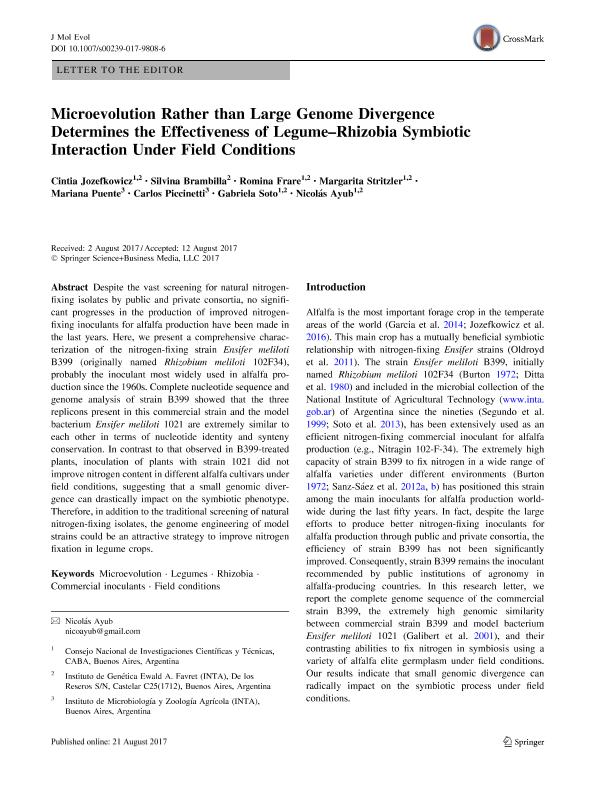Artículo
Microevolution rather than large genome divergence determines the effectiveness of legume-rhizobia symbiotic interaction under field conditions
Jozefkowicz, Cintia ; Brambilla, Silvina Maricel; Frare, Romina Alejandra
; Brambilla, Silvina Maricel; Frare, Romina Alejandra ; Stritzler, Margarita
; Stritzler, Margarita ; Puente, Mariana; Piccinetti, Carlos; Soto, Gabriela Cynthia
; Puente, Mariana; Piccinetti, Carlos; Soto, Gabriela Cynthia ; Ayub, Nicolás Daniel
; Ayub, Nicolás Daniel
 ; Brambilla, Silvina Maricel; Frare, Romina Alejandra
; Brambilla, Silvina Maricel; Frare, Romina Alejandra ; Stritzler, Margarita
; Stritzler, Margarita ; Puente, Mariana; Piccinetti, Carlos; Soto, Gabriela Cynthia
; Puente, Mariana; Piccinetti, Carlos; Soto, Gabriela Cynthia ; Ayub, Nicolás Daniel
; Ayub, Nicolás Daniel
Fecha de publicación:
08/2017
Editorial:
Springer
Revista:
Journal Of Molecular Evolution
ISSN:
0022-2844
Idioma:
Inglés
Tipo de recurso:
Artículo publicado
Clasificación temática:
Resumen
Despite the vast screening for natural nitrogen-fixing isolates by public and privateconsortia, no significant progresses in the production of improved nitrogen-fixinginoculants for alfalfa production have been made in the last years. Here, we present acomprehensive characterization of the nitrogen-fixing strain Ensifer meliloti B399(originally named Rhizobium meliloti 102F34), probably the inoculant most widely usedin alfalfa production since the 1960s. Complete nucleotide sequence and genomeanalysis of strain B399 showed that the three replicons present in this commercialstrain and the model bacterium Ensifer meliloti 1021 are extremely similar to eachother in terms of nucleotide identity and synteny conservation. In contrast to thatobserved in B399-treated plants, inoculation of plants with strain 1021 did not improvenitrogen content in different alfalfa cultivars under field conditions, suggesting that asmall genomic divergence can drastically impact on the symbiotic phenotype.Therefore, in addition to the traditional screening of natural nitrogen-fixing isolates, thegenome engineering of model strains could be an attractive strategy to improvenitrogen fixation in legume crops.
Palabras clave:
Microevolution
,
Rhizobia
,
Legumes
,
Commercial Inoculants
Archivos asociados
Licencia
Identificadores
Colecciones
Articulos(SEDE CENTRAL)
Articulos de SEDE CENTRAL
Articulos de SEDE CENTRAL
Citación
Jozefkowicz, Cintia; Brambilla, Silvina Maricel; Frare, Romina Alejandra; Stritzler, Margarita; Puente, Mariana; et al.; Microevolution rather than large genome divergence determines the effectiveness of legume-rhizobia symbiotic interaction under field conditions; Springer; Journal Of Molecular Evolution; 85; 3-4; 8-2017; 79-83
Compartir
Altmétricas



